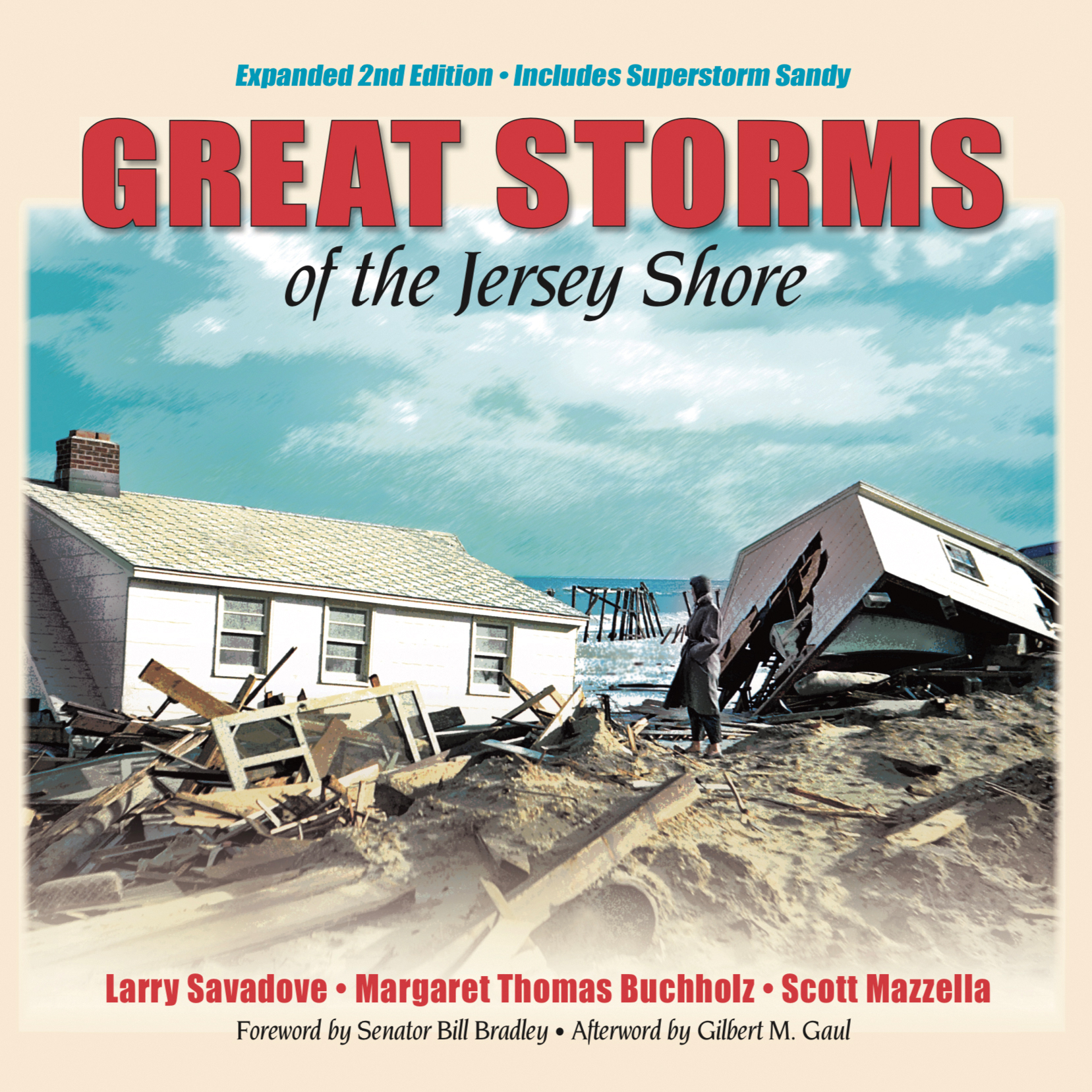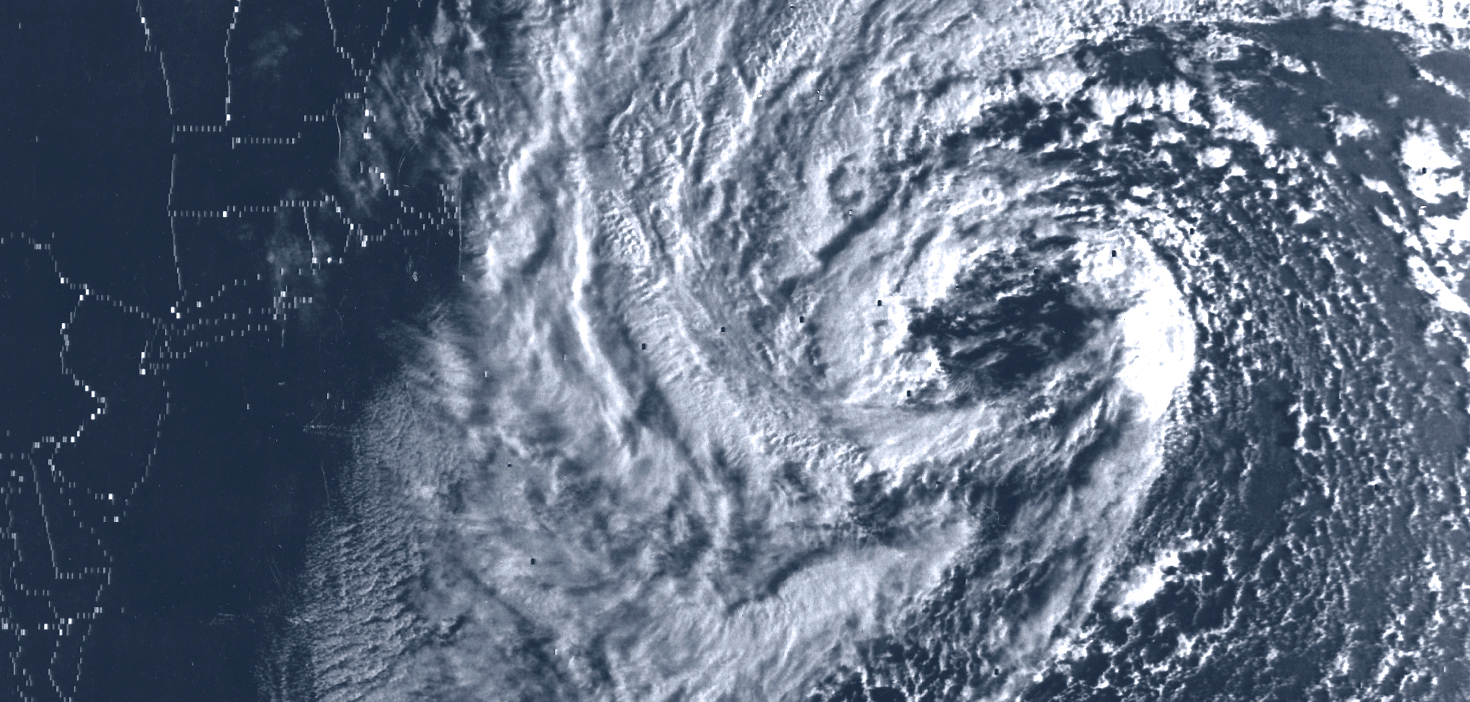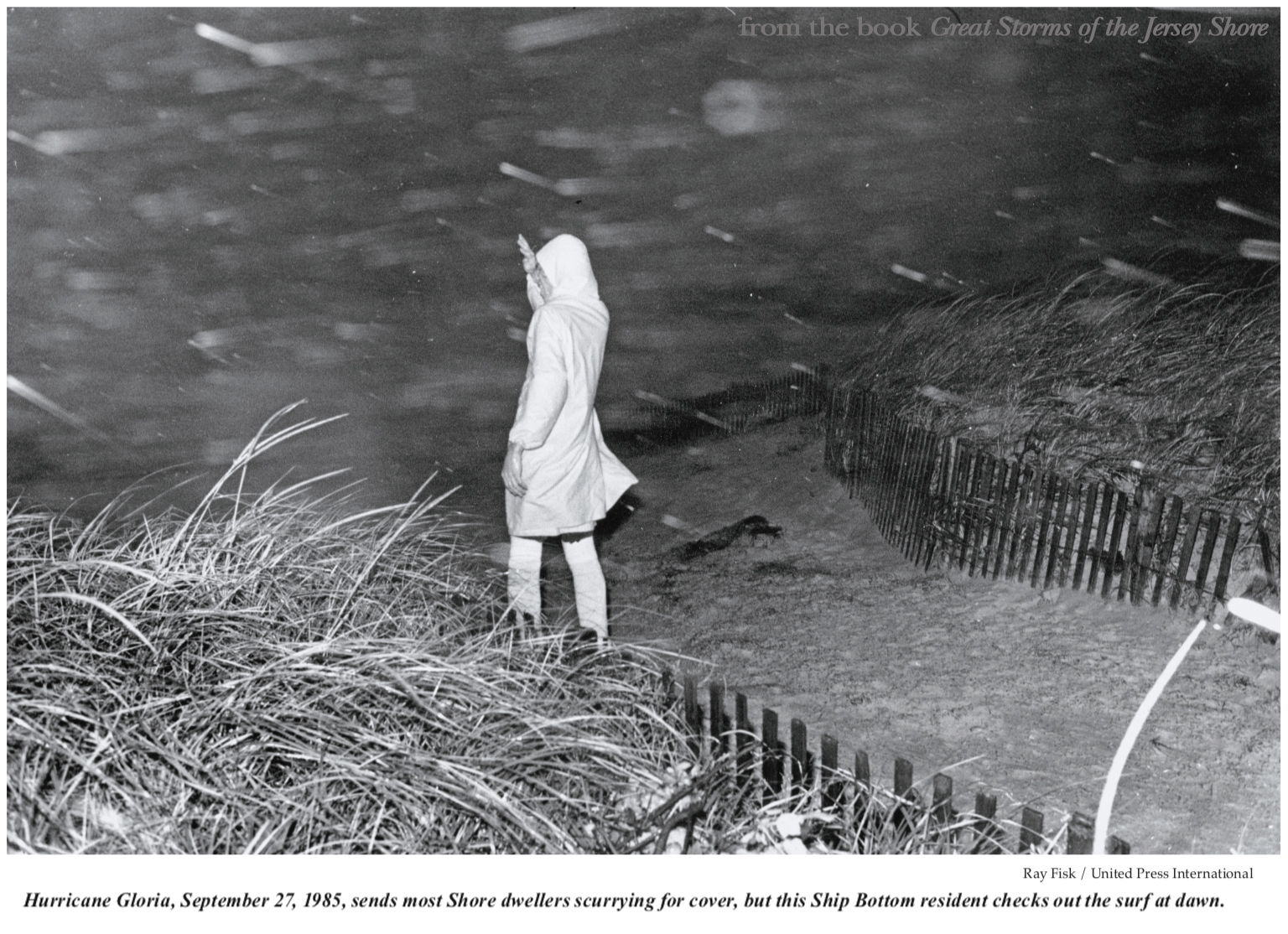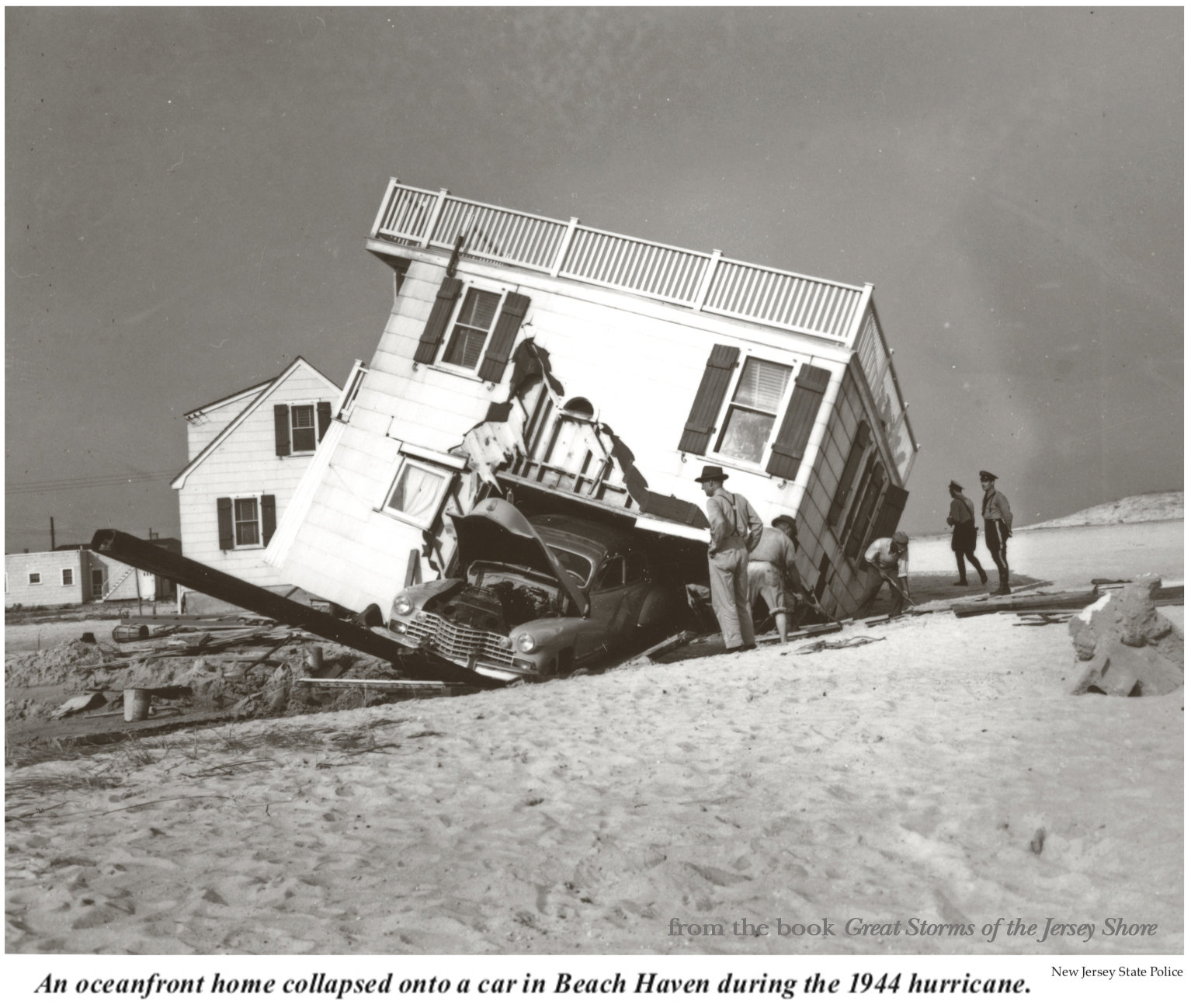
|
More Storm Stories
of the Jersey Shore |
|||
ISBN 978-1-59322-123-2

photos! >


On October 16, 1944, a month after the worst hurricane to hit the Island in the 20th Century, a man named Bob wrote the following letter to Muriel, Charles and Donald. We don’t know their last names or any more about them than appears in this long report, which Kathleen Donnelly discovered at the Long Beach Island Historical Museum in Beach Haven and brought to our attention. Bob had been striper fishing that day and – although they were staying “between two Coast Guard stations,” Bob complains -- they had no warning of the hurricane coming up the coast at the rapid forward speed of 35 mph. The family of four loaded their car at 3:50 p.m. and prepared to drive to the mainland.
We went about two miles down the road when we came to three cars stopped in water up their hub cabs. I shifted into second and slowly went ahead. I passed three cars when a breaker hit our left side, splashing in my window. It killed the engine so I decided to pull ahead on my starter and battery, when a garage floated toward us and stopped about 25 feet ahead of us – half on the road. I was afraid to continue past the garage for fear a wave would push it over on us, or my battery may go dead. If that happened we may be turned over and trapped in the car. I backed the car across the road and put the rear to the ocean. By that time the water was up to the seats. The waves were terrific. We opened all of the windows and just sat there. I held Lee and Ellen had Ruth. When a breaker came over us, we would hold the children to the ceiling. As the car completely filled, we would hold our hands over the childrens’ mouths and noses. When our faces went under, we would shut off their breathing until we could breathe again ourselves. The car would fill rapidly, but the water would also run out the window rapidly behind each breaker.
We were by then sitting in water up to Ellen’s elbows and we were scared to death, though neither mentioned it. The breakers came about 150 yards apart, and were about ten to one feet high. After a few minutes a big wave floated the car about 40 yards off the road toward the bay and turned it half way around. We were then facing the ocean. We continued our same tactics until a large breaker nearly turned the car over. My side went up in the air, I climbed out the window and held on to the top with my weight as far out from the car as possible. It finally settled on its wheels again. Ellen held both children and I just hung on to the steering wheel through the window. I went under the waves and if the car tilted I would put my weight out and a couple times more it did not go all the way over.
Finally we floated directly broadside with the ocean and I got back in as I was sure we would not turn over – but we did – the next breaker turned the car over two or three times and Ellen’s side landed on top. I immediately climbed out the top and Ellen handed me the children. The depth of the water was just to the top of the car as it laid on its side. I pulled Ellen out and told her to hang on to the window jamb with one hand and hold Lee with the other. He put both arms around her neck and just screamed continually. I held on with my right hand and put Ruth over my right shoulder and supported her back with my left hand. When a breaker went over us, I would try to pull my left shoulder and head around so the face of the wave would not hit Ruth’s head. I was so afraid it would break her neck or her back.
As we hung there, we went under the breakers just like diving through them in the surf. They would come and we would just hang on as they went about 10 feet over our heads. After each one I would look at Ruth, if she wasn’t crying, I would hit her back. She would then vomit up all she had swallowed. We did that for quite awhile – I really don’t know how long.
Finally I saw a huge wave coming. It really looked like a small tidal wave. I told Ellen to hang on tight as a big one was coming. After it went over us, I looked for Ellen and Lee but they were gone! Then I saw them floundering about 15 or 20 yards behind me. They were in a clump of [bayberry] bushes that grows between the ocean and the bay. The thought uppermost in my mind was, “We are done for anyway, so we may as well go together.” I let go of the car and staggered and swam with Ruth. Luckily the swift current landed me near them. I got Ellen to hold on to a limb of the bush. Lee was still screaming so I knew he was ok.
The Storm That Eats The Jersey Shore
by Larry Savadove
©1993 Down The Shore Publishing
Originally published as a cautionary tale in the original edition of Great Storms. This cautionary tale became prophetic, an experience close to reality with Superstorm Sandy in October 2012.
It begins in a flight of molecules. Bits of air spiral skyward, carrying water vapor high up to where the air cools and the vapor condenses.
In the Sahel in Africa, just below the Sahara, a farmer stands in his field, shading his eyes against the sun to look at a small collection of clouds forming in the east. He nods and goes back to hacking at the earth under his hoe. It is hard work but the earth yields to him. A few years before it would not. The Sahel had weathered a long drought, almost twenty years. Now it is ending.
Rain pours onto the brick-dry earth. The farmer does not pause in his work. The clouds pass. He turns and watches the small storm move off to the west, to the sea. The sea does not need your water, he thinks. I need it here. The sun leans on him. The ground has already absorbed the rain, but the air feels light. That is good. There will be more rain, he thinks, and returns again to his work.
The farmer is right. He does not know it, but he is working under a long trench in the atmosphere through which pass waves of low pressure. Low pressure brings winds and rain. High pressure brings sunshine and clear skies. The farmer knows nothing of highs and lows. But he knows the feel of the air.
Just off the coast, near the Cape Verde Islands, a lone fisherman eyes the flat sea, looking for his living. A shadow moves beneath the surface. He holds his breath, raises his net, sets his feet firmly against the sides of his small boat. There is a ripple. He casts the net. There is a quick flurry of movement and a small explosion of pent breath. The fish flaps desperately, pulled out of its natural element into a deadly environment of air, air full of oxygen it cannot use. In its futile thrashings, it pumps this useless matter through its gills.
The bits of air disturbed by the movement and the explosion and the struggle jostle one another, pushing for position. It is a small variation of the never-ending dance that distributes their parts of oxygen, nitrogen, argon, neon, carbon dioxide and water vapor with such efficiency that their proportions in a parcel of air at the surface of the sea are the same as that of a parcel sixty-five miles up.
But heavier. A given amount of air at sea level weighs more than the same amount above the clouds. A given amount of water, on the other hand, weighs as much at the bottom of the sea as it does just beneath the surface. This is because air can be compressed; water cannot. A person standing at at the bottom of either ocean bears the weight of all the parcels above him.
The fisherman does not stagger under his burden of air. He may not be aware that he carries it, but it is of no more concern to him than the weight of the sea under his boat. He does not know, either, that the pressure that he bears is not precisely the same as that which a fisherman in the South China Sea carries on his shoulders. Pressure at sea level varies from place to place in the world and from time to time —it’s 14.696 pounds per square inch along the East Coast of the United States — but it is enough of a constant to be named One Atmosphere or One G (for gravity). Scientists measure all other pressures by it, from the bottoms of mines to the tops of mountains.
Meteorologists measure pressure in inches of mercury or millibars. In 1643, Evangelista Torricelli invented the barometer, just a few years after Galileo invented the thermometer. They are still the two most basic tools of meteorology. Torricelli discovered that the weight of the atmosphere at sea level was just enough to support a column of water thirty-four feet high. He calculated that the water in the tube would fall by about one foot for every nine hundred feet of elevation.
A glass tube thirty-four feet high would be too unwieldy to haul up and down mountains. Torricelli soon found that a column of mercury about 30 inches high was the equivalent. It is this “glass” that mariners referred to in old sea logs. When the glass was dropping, it meant the atmospheric pressure was not enough to hold the mercury at the 30-inch level. Nobody knew about highs and lows then, only that a falling glass meant bad weather. Dropping below 29 inches was serious; anything below 28 inches was serious trouble. Sea level pressure on the East Coast is 29.92 inches, varying a bit with temperature.
The fisherman boats his catch, glances at the scuds of cloud to the east and decides to head home. Slants of warm rain wet him; the sun steams him dry; the clouds dissolve, reform, move west. This he can see. What he cannot see are the molecules of air he disturbed, rolling in the sun, growing warmer. The warmth excites them to greater activity. They push at one another. Small winds snatch at them, catch them up, spill them out again. Larger winds entrain them for longer runs.
 |
||||
|
email downshore@gmail.com • fax (609) 812-5098 Copyright © 2019 Down The Shore Publishing Corp. The words "Down The Shore" and logo are a registered U.S. Trademark. |
||||